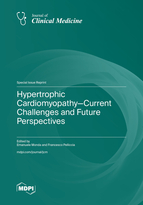Hypertrophic Cardiomyopathy—Current Challenges and Future Perspectives
A special issue of Journal of Clinical Medicine (ISSN 2077-0383). This special issue belongs to the section "Cardiology".
Deadline for manuscript submissions: closed (16 February 2023) | Viewed by 24523
Special Issue Editors
2. Institute of Cardiovascular Science, University College London, London, UK
Interests: myocardial diseases; cardiomyopathies; genetic cardiovascular disease; rare cardiovascular diseases; congenital heart diseases
Special Issues, Collections and Topics in MDPI journals
Special Issue Information
Dear Colleagues,
Hypertrophic cardiomyopathy (HCM) is a myocardial disease characterized by left ventricular hypertrophy not solely explained by abnormal loading conditions. HCM is a condition that ranges from benign to severe disease with complication (e.g., sudden cardiac death, heart failure, or atrial fibrillation).
The aetiology of HCM is heterogeneous, with mutations in sarcomeric genes responsible for up to 40–60% of cases. However, several other conditions (e.g., metabolic, infiltrative, and neuromuscular) can be associated with an HCM phenotype, often requiring a tailored diagnostic approach and treatment.
Current research is focused on identifying diagnostic markers and molecular targets to early identify the specific cause of HCM and start a tailored treatment, when available.
This Special Issue aims to identify the gaps in the diagnosis and management of HCM based on a combination of original research and review papers.
Potential topics include:
- The epidemiology of HCM;
- The pathophysiology of HCM, both sarcomeric and rare aetiologies;
- The role of genetics in the diagnosis of HCM;
- Diagnostic approaches, including multimodality imaging and novel techniques;
- Medical and surgical treatments;
- Specific aetiologies of HCM (e.g., Fabry disease, cardiac amyloidosis, and glycogenosis);
- Paediatric HCM.
Dr. Emanuele Monda
Prof. Dr. Francesco Pelliccia
Guest Editors
Manuscript Submission Information
Manuscripts should be submitted online at www.mdpi.com by registering and logging in to this website. Once you are registered, click here to go to the submission form. Manuscripts can be submitted until the deadline. All submissions that pass pre-check are peer-reviewed. Accepted papers will be published continuously in the journal (as soon as accepted) and will be listed together on the special issue website. Research articles, review articles as well as short communications are invited. For planned papers, a title and short abstract (about 100 words) can be sent to the Editorial Office for announcement on this website.
Submitted manuscripts should not have been published previously, nor be under consideration for publication elsewhere (except conference proceedings papers). All manuscripts are thoroughly refereed through a single-blind peer-review process. A guide for authors and other relevant information for submission of manuscripts is available on the Instructions for Authors page. Journal of Clinical Medicine is an international peer-reviewed open access semimonthly journal published by MDPI.
Please visit the Instructions for Authors page before submitting a manuscript. The Article Processing Charge (APC) for publication in this open access journal is 2600 CHF (Swiss Francs). Submitted papers should be well formatted and use good English. Authors may use MDPI's English editing service prior to publication or during author revisions.
Keywords
- hypertrophic cardiomyopathy
- left ventricular hypertrophy
- genetics
- multimodality imaging
- diagnosis
- treatment
- personalized medicine
- cardiac amyloidosis
- Fabry disease
- glycogen storage disorders
- RASopathies
- lysosomal storage disorders
- mitochondrial disorders








